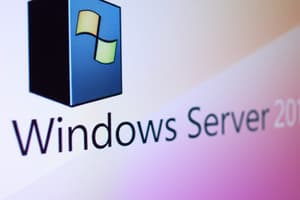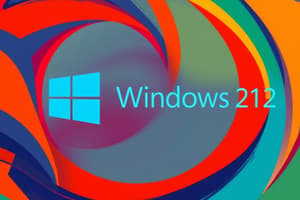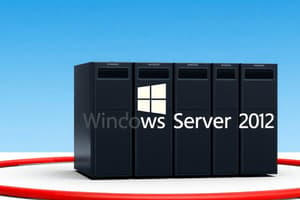Podcast
Questions and Answers
What primarily determines the functions a server performs?
What primarily determines the functions a server performs?
- The size of the server
- The hardware specifications of the server
- The type of business using the server (correct)
- The server software installed
A computer becomes a server solely based on its hardware specifications.
A computer becomes a server solely based on its hardware specifications.
False (B)
What is the function of a server operating system in a network?
What is the function of a server operating system in a network?
To provide services that aid the operations of an organization.
A server's capabilities are influenced by the __________ of the business using it.
A server's capabilities are influenced by the __________ of the business using it.
Match the following Windows Server 2012/R2 concepts with their descriptions:
Match the following Windows Server 2012/R2 concepts with their descriptions:
Which of the following is a primary function of server operating systems?
Which of the following is a primary function of server operating systems?
Windows 10 supports an unlimited number of logged-on network users.
Windows 10 supports an unlimited number of logged-on network users.
Name one fault-tolerance feature supported by Windows Server 2012/R2.
Name one fault-tolerance feature supported by Windows Server 2012/R2.
Windows Server 2012/R2 includes services such as _____ and _____ for network functionality.
Windows Server 2012/R2 includes services such as _____ and _____ for network functionality.
Match the Windows Server 2012/R2 editions with their features:
Match the Windows Server 2012/R2 editions with their features:
What are the two main components of a network interface?
What are the two main components of a network interface?
The network client sends requests to a server for resources.
The network client sends requests to a server for resources.
What is the main purpose of server roles in Windows Server?
What is the main purpose of server roles in Windows Server?
The software in Windows that allows sharing of files and printers across a network is called __________.
The software in Windows that allows sharing of files and printers across a network is called __________.
Match the following network components with their descriptions:
Match the following network components with their descriptions:
Which of the following best describes a server feature?
Which of the following best describes a server feature?
Active Directory Certificate Services is responsible for issuing physical certificates.
Active Directory Certificate Services is responsible for issuing physical certificates.
What does a network protocol determine?
What does a network protocol determine?
A __________ is composed of two parts: the network interface card and the device driver software.
A __________ is composed of two parts: the network interface card and the device driver software.
Which role provides services for creating and managing digital certificates?
Which role provides services for creating and managing digital certificates?
Flashcards are hidden until you start studying
Study Notes
Objectives of Windows Server 2012/R2
- Understand the server operating system's function in networks.
- Familiarize with different editions of Windows Server 2012/R2.
- Define terms related to private cloud technologies.
- Explore core technologies integrated into Windows Server 2012/R2.
- Learn about various roles within Windows Server 2012/R2.
- Recognize new and enhanced features in Windows Server 2012/R2.
Role of a Server Operating System
- Server function is influenced by business type, size, and technology commitment.
- Provides essential services to facilitate organizational operations.
- Transforming a computer into a server requires specific software installations.
Server vs. Desktop Operating Systems
- Windows Server 2012/R2 offers robust network services:
- File and Printer sharing
- Web server capabilities
- Routing and Remote Access Services (RRAS)
- Domain Name System (DNS)
- Dynamic Host Configuration Protocol (DHCP)
- FTP Server
- Active Directory
- Distributed File System (DFS)
- Hyper-V for virtualization
- Windows 10 desktop has limited server functionalities, supporting only certain services.
Editions of Windows Server 2012/R2
- Streamlined editions compared to Windows Server 2008:
- Datacenter
- Standard
- Essential
- Foundation
- Selection based on organizational size and required services.
Network Components
- Network connection comprises networking components like NIC and device drivers.
- Network protocols establish rules and formats for device communication.
Windows Server Roles
- Server roles indicate major functions or services provided by the server.
- Role services enhance main roles, while features support or add standalone functions.
- Configurable for single or multiple roles depending on needs.
Key Server Roles
- Active Directory Certificate Services (AD CS): Manages digital certificates.
- Active Directory Domain Services (AD DS): Provides authentication and authorization for users/computers.
- DHCP Server: Automatically assigns IP addresses and configurations.
- DNS Server: Resolves Internet and Windows Domain names to IP addresses.
- Hyper-V: Facilitates creation and management of virtual machines.
- Remote Access: Configures servers for VPN and Direct Access, enhancing secure remote connectivity.
- Windows Deployment Services (WDS): Simplifies Windows installation over a network.
New and Enhanced Features
- Server Core: Lightweight installation option.
- Minimal Server Interface: Reduced graphical interface for efficiency.
- PowerShell: Command-line interface with numerous commands (cmdlets) for management.
- Storage Spaces: Advanced storage management.
- Resilient File System (ReFS): Improved file system for robust storage solutions.
- IP Address Management (IPAM): Tools for monitoring and managing DHCP/DNS servers.
- Dynamic Access Control: Enhanced resource access management.
Summary
- A server's identity is primarily determined by the software running on its hardware, emphasizing the crucial role operating systems play in server functionality.
Studying That Suits You
Use AI to generate personalized quizzes and flashcards to suit your learning preferences.




